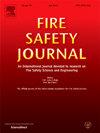预测生物基绝缘材料阴燃行为的数值模型:模型理论与验证
IF 3.4
3区 工程技术
Q2 ENGINEERING, CIVIL
引用次数: 0
摘要
生物基绝缘材料着火后容易发生自燃。虽然实证研究强调了影响阴燃发生和蔓延的关键因素,但对其机制的全面理解仍不完整。本文介绍了生物基保温材料的阴燃模型,该模型将流动、热量和水分传递与三步反应模型相结合。材料参数量化以木纤维绝缘材料为参考,方法适用于其他材料。实验设置流体力学,热,和水分输送特性进行了描述,并辅以文献数据。该模型框架将流动、热量和水分传输机制与依赖于温度和浓度的反应速率耦合在一起。扩散限制方法解释了粒子表面输运约束。使用COMSOL Multiphysics®6进行实现。在控制加热区和流入条件的1.5 m管式炉上进行的验证试验表明,该模型能够准确预测阴燃速度。需要进一步优化以改善点火时间预测。虽然没有完全捕获一些非同质性影响,但该模型为进一步细化和扩展到组件级别提供了坚实的基础。本文章由计算机程序翻译,如有差异,请以英文原文为准。
A numerical model for predicting the smoldering behavior of bio-based insulation materials: Model theory and validation
Bio-based insulation materials are prone to self-sustained smoldering after ignition. While empirical studies highlight key factors influencing smoldering initiation and spread, a comprehensive understanding of the mechanisms remains incomplete. This study introduces a smoldering model for bio-based insulation materials, integrating flow, heat, and moisture transfer with a 3-step reaction model.
Material parameter quantification is demonstrated using wood fiber insulation as a reference, with methodologies applicable to other materials. Experimental setups for fluid mechanical, thermal, and moisture transport properties are described, supplemented by data from literature.
The modeling framework couples flow, heat, and moisture transport mechanisms with reaction rates dependent on temperature and concentration. A diffusion-limiting approach accounts for particle-surface transport constraints. Implementation is performed using COMSOL Multiphysics ® 6.
Validation tests in a 1.5 m tube furnace with controlled heating zones and inflow conditions demonstrate the model's ability to accurately predict smoldering velocity. Further optimization is required to improve ignition time predictions. While some inhomogeneity effects are not fully captured, the model provides a solid foundation for further refinement and scaling to component levels.
求助全文
通过发布文献求助,成功后即可免费获取论文全文。
去求助
来源期刊

Fire Safety Journal
工程技术-材料科学:综合
CiteScore
5.70
自引率
9.70%
发文量
153
审稿时长
60 days
期刊介绍:
Fire Safety Journal is the leading publication dealing with all aspects of fire safety engineering. Its scope is purposefully wide, as it is deemed important to encourage papers from all sources within this multidisciplinary subject, thus providing a forum for its further development as a distinct engineering discipline. This is an essential step towards gaining a status equal to that enjoyed by the other engineering disciplines.
 求助内容:
求助内容: 应助结果提醒方式:
应助结果提醒方式:


